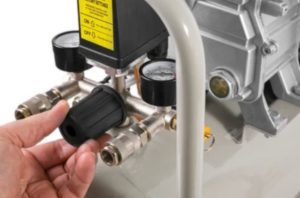 For the last many years, Air compressors have become vital components of any workshop or factory.
For the last many years, Air compressors have become vital components of any workshop or factory.
They are quite versatile and have become smaller and considerably less bulky in recent years.
This makes them more usable in multiple work situations. Not only that, but these are also quite highly useful portable machines that power single air tools.
The main factor that makes air compressors special and unique is that they’re much more reliable and powerful than regular tools without the need to have their own bulky motors.
As the only major maintenance needed is a little bit of oiling, a variety of tools can easily be powered by a single engine that just utilizes air pressure for maximum potential.
The versatility of air compressors doesn’t just stop at the workbench for drills or sanders, they can also be used for almost anything from inflating a tire to unclogging the sink at home.
It’s very important to understand how to turn them on properly in order to avoid any inconvenience.
How does it actually work?
Air compressors function by simply forcing air into a container and pressurizing it.
The air is then forced through an opening in the tank exactly where pressure builds up.
You can take it as an open balloon, the air compressed in it can be used as energy when it’s released.
Air compressors are usually powered by an engine that converts electrical energy into kinetic energy.
It’s considered quite similar to how a combustion engine works, using a piston, crankshaft, head, valve, and a connecting rod.
So the pressurized air can also be used to power a variety of tools and devices. Some of the options are impact wrenches, nailers, sanders and paint sprayers.
Furthermore, there are different types of air compressors in the market and each one has a different specialty.
Also, as a matter of fact, the differences are not that severe, the major point of differentiation is about the way a compressor handles air displacement.
Learn how to turn on the air compressor
Check the oil
In the first step, you need to check the pump oil level if you have a compressor that is not oil-free.
Well, Old compressors and as well as large ones, are mostly oil-filled.
Then, locate the dipstick near the bottom of one of the compressor’s ends and pull it out to check that whether the oil level reaches about ⅔ of the way up the stick or not.
If not, it would be better to pour some compressor oil into the tank.
So, if you need oil, it can easily be found at most hardware, home improvement, and auto parts stores.
If you are not exactly sure about the kind of compressor you have, it is recommended to consult the owner’s manual.
Nowadays, most small compressors are now oil-free, so there are chances that you might not see a dipstick or an oil tank.
Connect the hose to the valve
Now you have to simply connect the hose to the regulator valve.
Start with setting the compressor on flat ground. Look for the regulator valve, which is in most cases right next to the smaller pressure gauge on 1 end of the compressor.
It’s a copper-coloured, round metal plug with a big hole in the middle.
Just push the pointed end of the hose into the valve in order to attach it.
Connect the power tool
In this step, you need to plug the power tool into the hose.
Then, hold the hose in 1 hand and the power tool in the other and slide the tool’s plug into the hose’s free end.
After this, just twist them together until the tool properly locks in place.
Note that, if the tool is on securely, it won’t slide off. Plus, If you are pumping a tire, push the coupler onto the tire’s valve.
Plug the compressor into an outlet
Once you achieve success in the previous steps, you just need to plug the compressor into a grounded 3-prong outlet in this step.
It is very important to make sure that the compressor’s power switch is not turned on before plugging it in. It would be better if you avoid using extension cords if it’s not possible to reach a working outlet.
Instead, do it properly, just get another air hose and plug it into the first one.
In order to attach two hoses together, you have to slide the plug end of one hose into the other receiving end on the other hose.
It actually works the same way as connecting a power tool to the hose.
Another important thing to know is that it is never considered suitable to use extension cords as they can cause the compressor to overheat.
Finally, it is recommended to take precautions every time to make your work efficient and safe.
- How To Make A Confetti Cannon With An Air Compressor - December 4, 2022
- How To Keep Air Compressor From Freezing - December 3, 2022
- How To Install Oil Water Separator On Air Compressor - December 2, 2022